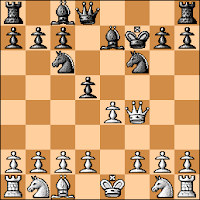
From a recent email from Garry Gifford, editor of the Unorthodox Openings Newsletter and one of the authors (along with Davide Rozzoni and Bill Wall) of the new Winning with the Krazy Kat and Old Hippo (see my review of the book at Chessville) -
...On a related note, last Saturday I played in Martin Frere Hillyer's first Thomas Frere Chess Memorial tournament (an unrated unadvertised invitational event) . [See my review of Hillyer's impressive Thomas Frère and the Brotherhood of Chess: A History of 19th Century Chess in New York City - RK]
In round 4 I drew with a guy and had to play a 5 minute tie-break game to see who would get the "gold" and who would get the "silver." These were not real gold and real silver, of course, just colored metal to resemble the actual.
So, having black and facing a very booked up player (who was also great at speed chess), I played the Krazy Kat. This was for the Gold, so you can see I take the Kat seriously (also a crowd was watching). Sure enough, my plan was a good one.
White was taking a great deal of time in the opening and early middle game and I could move at the speed of a crazy cat. But perhaps I moved too fast. In the middle game my opponent calculated a way to exchange pawns, pin a knight, gang up on it, and win it. And he did.
But at the cost of much time. I had 1 minute and 14 seconds showing on the clock. He had 6 seconds. "Avoid getting mated and the Gold is yours," said my inner self. And so I toughned up the defense while making some threats of my own with queen and rooks on open files. And 6, 5, 4, 3, 2 1... Black won on time.
Phew! So, I owe the gold to the Krazy Kat.
(By the way, the English Chess Forum has some interesting posts on the Hippopotamus and its creator. And Chess.com has a nice discussion on the Krazy Kat started by author Bill Wall - RK)











 7.Qd5+ Kf8 8.Qxc5+ d6 9.Qe3 Be6
7.Qd5+ Kf8 8.Qxc5+ d6 9.Qe3 Be6 
 RevvedUp prefers this quieter move to Hiarc 8's choice in the last game of ...d5 (see "
RevvedUp prefers this quieter move to Hiarc 8's choice in the last game of ...d5 (see " Hiarcs 8 has adopted an interesting positional approach to the position that looks effective for White, even though Black may still retain a bit of his advantage.
Hiarcs 8 has adopted an interesting positional approach to the position that looks effective for White, even though Black may still retain a bit of his advantage. 16...dxe5
16...dxe5 Black's King is in grave danger.
Black's King is in grave danger.









 The rest of the game is not pretty, and in another 10 moves you can start counting the checkmates that I missed, but I'd rather draw the curtain here.
The rest of the game is not pretty, and in another 10 moves you can start counting the checkmates that I missed, but I'd rather draw the curtain here.








